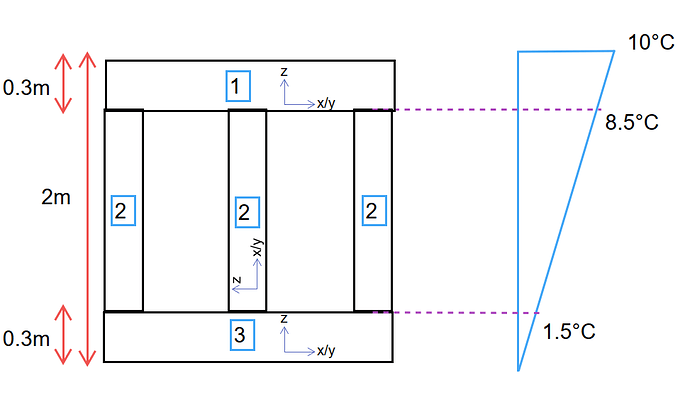Hi, I’m looking at applying temperature loads according to Eurocode using Teddy.
For a model with beam elements, applying the uniform and varying temperature components seems fairly doable using teddy:
First question - for the case where the top of the beam is warmer than the bottom (EN1991-1-5 Table 6.1), is it correct to use a negative value for the DTZ? As I understand a positive value causes expansion at the +Z side of the element
// Uniform
LC 81 TYPE none TITL 'TN-summer'; BEAM GRP 120 TYPE DT 20
//Varying
LC 83 TYPE none TITL 'DT warm on top'; BEAM GRP 120 TYPE DTZ -10;
Now say I have a model where my cross section is built out of plate elements as in the image below and the plates are grouped into groups 1, 2 and 3 as indicated.
I understand that the DTXY attribute is used for uniform temperatures. So for the uniform case is as follows:
// Uniform
LC 81 TYPE none TITL 'TN-summer'; QUAD GRP 1,2,3 TYPE DTXY 20
The DTZ attribute serves a similar function as for the beams. BUT in my case I have a rotated plate creating the web of my section. Using DTZ in this case doesn’t make sense as that now points to the side of the bridge and not vertical (see local coordinate system shown in sketch). I tried using a DTX or DTY attribute but that doesn’t seem to exist. So my second question is how do I define a varying temperature for this web plate?
So far I have used the following for the plate situation (breaking the temperature curve into constant and varying components):
LC 83 TYPE none TITL 'DT warm on top'
QUAD GRP 1 TYPE DTXY -8.5; QUAD GRP 1 TYPE DTZ -1.5 // Top plate
QUAD GRP 2 TYPE DTXY -1.5; QUAD GRP 2 TYPE ..... // Middle plate unknown??
QUAD GRP 3 TYPE DTZ -1.5 // Bottom plate
Thanks in advance, any help/advice is appreciated.
